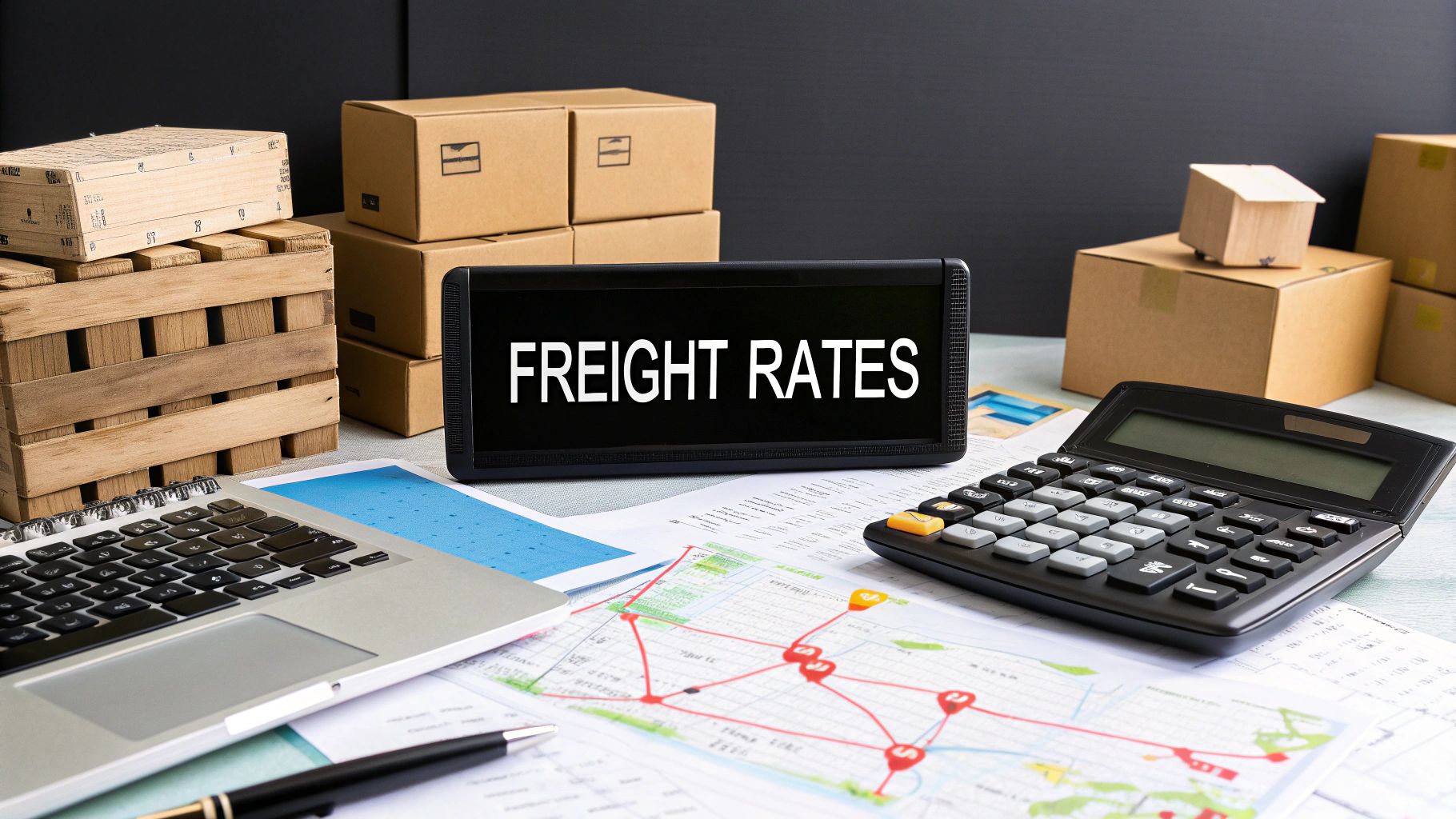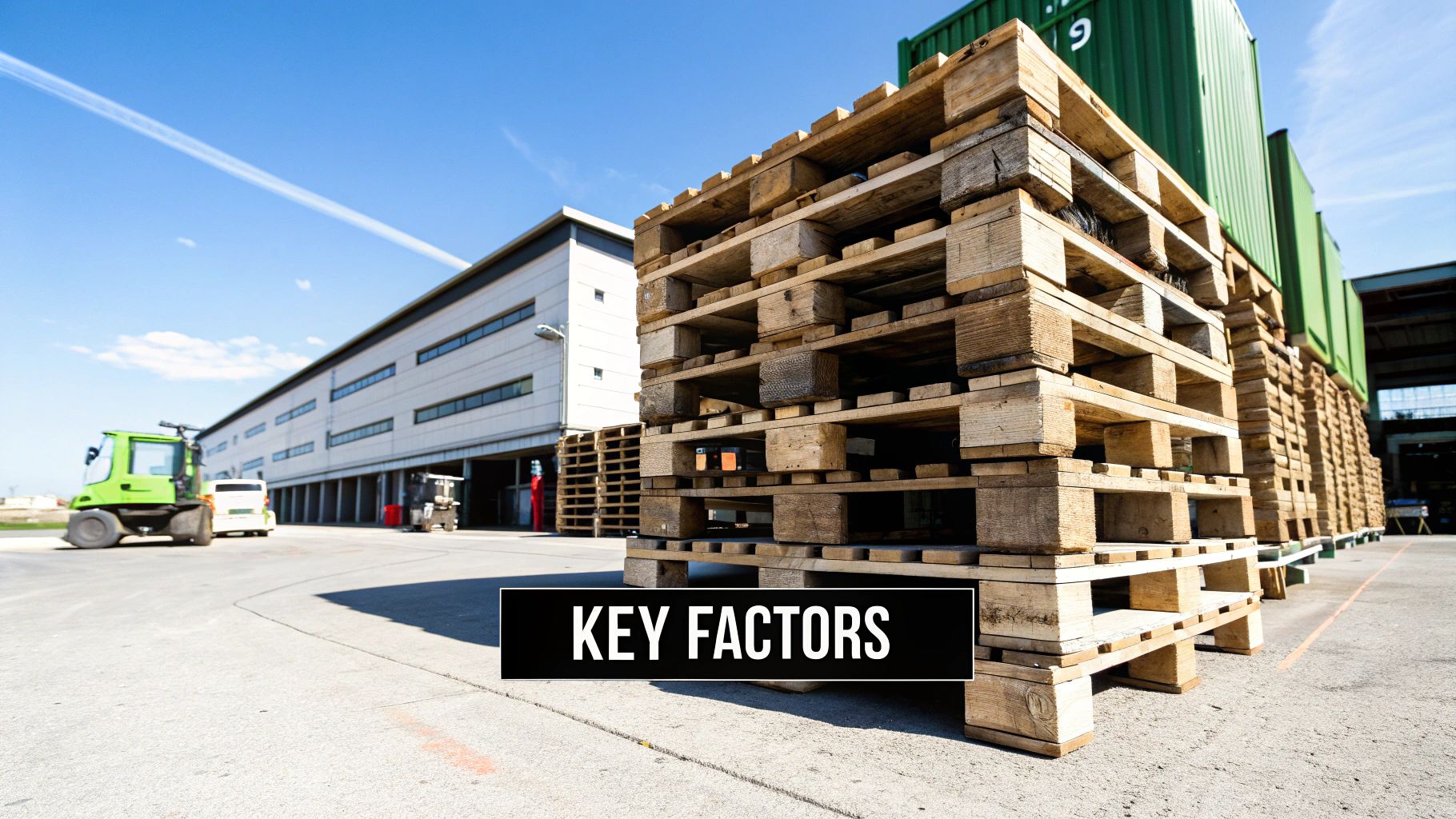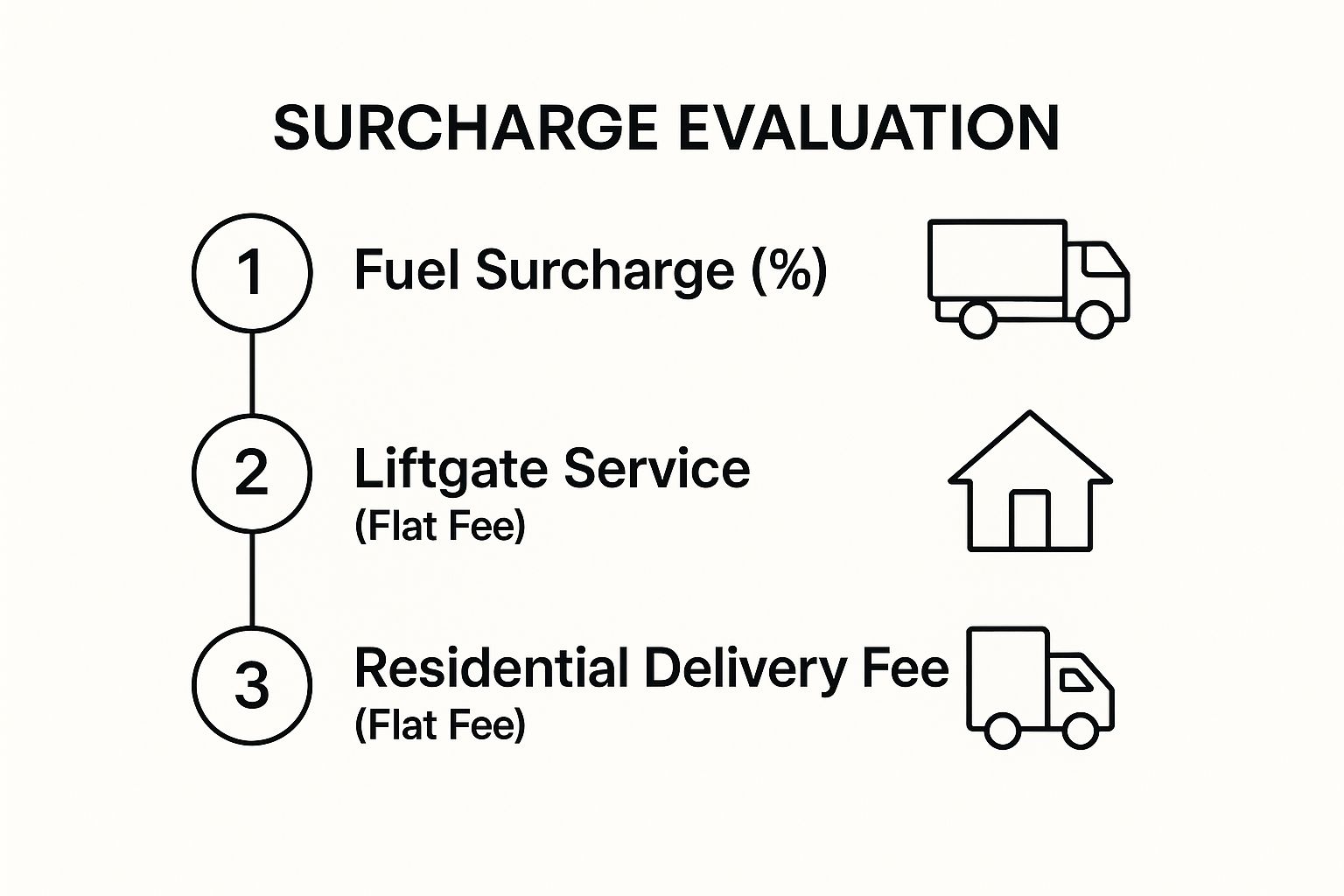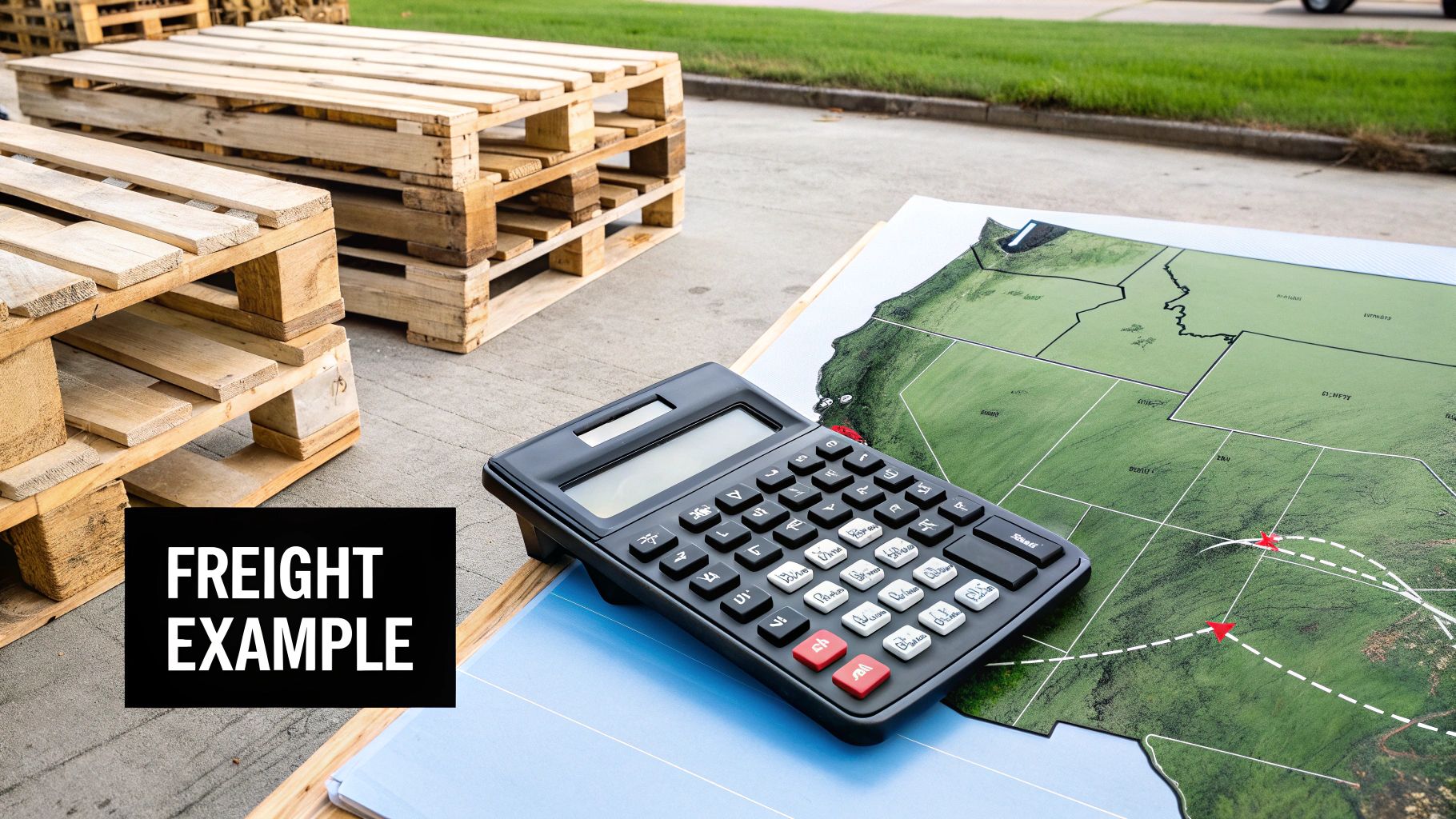Learn how to calculate freight rates like a pro. Our guide breaks down the key factors like freight class, density, and fees for an accurate shipping quote.

Calculating freight rates really boils down to a few key things: how far your shipment is going, its size and weight, and what you're actually shipping. I always tell people to think of it like a recipe. The distance, dimensions, density, and freight class are the core ingredients that mix together to create your final cost.
Before you can get an accurate freight rate, you need to understand what carriers are looking at when they build their quotes. It's not just about getting from point A to point B; every little detail about your shipment matters. Knowing this stuff helps you prepare your shipment info correctly and, more importantly, helps you avoid those surprise charges that can pop up later.

Ready to see how all these pieces come together for your shipment? You can skip the manual math and find out your rate in seconds.
Let's break down the main factors that influence your final shipping cost. Getting these details right is the most important step in getting a quote you can count on.
Think of these as the non-negotiables. You have to have this information nailed down before a carrier can give you a real number.
The very first question to answer is whether your shipment is LTL (Less-Than-Truckload) or FTL (Full-Truckload). This single detail completely changes how the price is calculated.
Figuring out which bucket your shipment falls into is step one to getting a quote that makes sense.
When it comes to LTL shipping, freight class is one of the most important—and frankly, most misunderstood—parts of the equation. It’s a standardized system that gives carriers a uniform way to price all kinds of different items. Your freight's class is determined by its density, how easy it is to stow, any special handling it needs, and its liability. We have a whole guide that digs into how freight class is determined if you want to go deeper.
A Pro Tip From Experience: A lower freight class (Class 50 for something dense and durable like steel) means a lower shipping cost. A higher class (Class 500 for something super light and fragile like ping pong balls) costs a lot more. Getting this number wrong is the most common reason I see for unexpected charges after the fact.
It's also worth noting how cost per unit can be misleading. For example, a shipment costing $1,200 to move 600 units gives you a cost of $2.00 per unit. But if a different lane costs $900 for 400 units, your cost per unit is actually higher at $2.25. The lower total cost doesn't always mean it's the most efficient.
Once you have a handle on these core elements—LTL vs. FTL and the all-important freight class—you're in a much better position to understand your shipping costs.
If you really want to get a handle on freight rates, you have to start thinking like a carrier. The final price on your quote isn't pulled out of thin air; it’s a careful calculation based on five core factors. Getting a grip on these is the secret to dodging surprise fees and actually managing your shipping budget.

Let's break down each of these five components to see how they all fit together.
It’s pretty obvious that the farther your freight goes, the more it will cost. Carriers use specialized software to clock the mileage between origin and destination ZIP codes. But it's not just about the miles—it's about the lane.
A "lane" is just industry jargon for the specific route between two points. A popular, high-traffic lane like Los Angeles to Phoenix often has a lower cost-per-mile than a route out to a remote town. Why? Supply and demand. More trucks run the popular lanes, which creates competition and drives down prices.
This is all based on a carrier's operating costs. The American Transportation Research Institute (ATRI) found that the average marginal cost per mile for trucking companies hit $1.82 in 2022. That figure, which is heavily influenced by fuel prices and driver wages, is the baseline that every freight rate is built upon.
The weight of your shipment is a simple number, but its density is just as important, especially when you're shipping Less-Than-Truckload (LTL). Density measures how much space your shipment takes up relative to its weight, calculated in pounds per cubic foot.
Think of it this way: carriers are selling space on their truck. That space is their most valuable asset. A pallet of heavy steel bars might not take up much room, but it adds a lot of weight. On the flip side, a pallet of fluffy pillows is light as a feather but hogs a ton of space. The pillows could actually end up costing more to ship because they prevent the carrier from loading other, heavier (and more profitable) freight onto the truck.
This concept of density leads us straight to freight class. This is the system that standardizes pricing for millions of different products being shipped. Governed by the National Motor Freight Classification (NMFC), freight class is a number between 50 (cheap to ship) and 500 (very expensive to ship).
Four main things determine your shipment's class:
Getting the freight class right is probably the single most important thing you can do in LTL shipping. I can't tell you how many times I've seen customers get hit with extra fees because of a re-classification.
Pro Tip: When you're calculating density and freight class, always use the final dimensions and weight of the palletized freight. Don't just measure the product itself. This one small step can save you hundreds in billing adjustments.
The shipping mode—whether you choose Full Truckload (FTL) or Less-Than-Truckload (LTL)—sets the entire pricing structure. FTL is usually much simpler, often just a flat rate per mile for the entire truck. LTL, on the other hand, is where all these little details like density and freight class come into play to build your final rate.
The base rate is the foundation of your LTL quote, determined by the factors we've already covered. But it’s never the final price. On top of that, carriers add various accessorial fees and surcharges.
The most common one you'll see is the fuel surcharge, which fluctuates with the price of diesel. Other common charges include fees for residential delivery, liftgate service, or appointments. Understanding these potential add-ons is key to forecasting your total cost accurately.
Learning to manage these five factors puts you in the driver's seat. It's not just about finding a cheap rate; it's about understanding the value you're getting and ensuring your costs are predictable.
Beyond these shipping-specific elements, it's also smart to look into general strategies to reduce operational costs for your business, as freight is often a big piece of that puzzle.
Think of your base freight rate as just the starting point. The number you really need to watch is the final cost, which often includes a variety of extra charges known as accessorial fees or surcharges. If you're not paying attention, these can quickly inflate your shipping bill.
Basically, the base rate covers the standard dock-to-dock movement of your freight. Accessorials are fees for any service that goes beyond that simple A-to-B transport—anything requiring special equipment, extra time, or more complex handling from the carrier. Getting a handle on these is crucial for accurately forecasting your total shipping spend and avoiding those nasty invoice surprises.
This infographic breaks down how some of the most common flat-fee surcharges get tacked on after the initial fuel percentage is calculated.

As you can see, each special requirement for a shipment adds another layer of cost, building up to your final total.
While the list of potential fees is long, there are a handful that pop up on quotes all the time. Learning to spot these—or better yet, knowing when to ask for them upfront—is a skill that will save you a lot of headaches and money.
Here are the usual suspects you'll run into:
Not sure which fees might apply to your shipment? Our team can walk you through it and build a comprehensive quote with no hidden costs.
Alright, let's move from theory to practice. Seeing how all these pieces fit together in a real-world scenario is the best way to make sense of freight rates. We'll walk through a common Less-Than-Truckload (LTL) shipment from start to finish.
Imagine you’re a manufacturer shipping four identical pallets from your warehouse in Chicago, IL (ZIP 60601) to a customer's shop in Dallas, TX (ZIP 75201). This is a classic LTL situation.

Before you can even think about getting a quote, you have to know exactly what you're shipping. These details are the foundation of any freight calculation.
For our Chicago-to-Dallas shipment, here’s what we have:
Tired of doing the math yourself? You can skip the manual work and get an instant price for your own shipment right now.
With the basic stats in hand, we can now calculate the density to determine our freight class. This is where things get interesting.
First, we need the total volume in cubic feet.
Now, we can find the density.
Looking at the official NMFC standards, a density of 5.4 PCF places this shipment squarely in Freight Class 150. This class is for goods that are fairly light for the amount of space they take up on a truck.
This is where the quote starts to take shape. The carrier's system takes the origin, destination, weight, and freight class and spits out a base rate. For a 1,200-pound, Class 150 shipment from Chicago to Dallas, a carrier might quote a base rate of $650.00.
But that’s never the final price. Now we have to add the surcharges.
The base rate is just the starting line. It's the accessorial fees and surcharges that reveal the true cost of shipping. Getting this part right is key to avoiding budget blowouts.
Let's add it all up. This is how you get from a few shipment details to a real, all-in freight quote.
Walking through this process shows you exactly how a quote is built, piece by piece. When you understand this flow, you can better prepare your freight, anticipate the final costs, and avoid any nasty surprises when the invoice arrives.
Remember the old days of calculating freight rates? It usually involved a spreadsheet, a phone, and a whole lot of patience. You’d spend hours calling carrier after carrier, jotting down base rates, and trying to make sense of all the different fees. Thankfully, that’s a thing of the past.
Technology has completely changed the game, making the entire process faster, more accurate, and just plain easier. The manual grunt work has been swapped out for powerful digital tools that do the heavy lifting for you.
At the center of this shift are online freight calculators and, more importantly, Transportation Management Systems (TMS). These platforms are plugged into huge networks of carriers. All you have to do is enter your shipment details once, and you’ll get dozens of competitive rates to compare side-by-side in seconds.
It’s basically a search engine for your freight. You pop in the origin, destination, weight, and freight class, and the system instantly pulls the best available options. This lets you compare not just the price, but also transit times and carrier reputations, so you can make a genuinely informed decision every single time.
Ready to see how fast it can be? Stop calculating and start comparing.
It gets even better. The best modern freight platforms don't just compare static rate cards. They tap into advanced analytics and market intelligence tools to give you quotes based on what's happening in the market right now. They analyze supply and demand, current fuel costs, and other economic factors to ensure you’re getting a truly competitive rate.
If you want a real-world example of how wild the market can get, look at the Freightos Baltic Index (FBX). It tracked the spot rate for a 40-foot container from China to the U.S. West Coast jumping from around $1,400 in January 2020 to an eye-watering $20,000 by September 2021. That’s a 1,300% spike! This is exactly why dynamic, data-driven quoting is no longer a "nice-to-have"—it's a necessity. You can dive deeper by exploring the latest global freight insights.
The biggest edge modern tech gives you is access to market data you could never gather on your own. It stops being about finding one cheap quote and starts being about understanding the entire shipping landscape to consistently secure the best value.
Relying on these digital platforms is simply the smartest way to manage your shipping today. You save a massive amount of time, often get better pricing through the platform's aggregated volume discounts, and make choices based on solid, up-to-the-minute information. Why do it the hard way?
Look, even after breaking it all down, you probably still have a few questions floating around. That’s completely normal. Freight pricing is a complex beast, so let's clear up some of the most common questions we get from shippers just like you.
Hands down, the most common—and most costly—mistake is getting the freight class wrong.
This usually happens one of two ways: either a shipper guesses the weight and dimensions instead of getting precise measurements, or they just don't quite grasp the NMFC guidelines. When the carrier catches the error (and they almost always do), they'll re-weigh and re-classify your shipment right in the middle of its journey.
That doesn't just mean a small price adjustment. It means a surprise invoice that's significantly higher, plus some hefty correction fees tacked on for the trouble. The fix is simple: always measure and weigh your shipment after it's been crated or palletized. If you're on the fence about the class, use a freight class calculator or just ask an expert.
Don't let a simple oversight sink your budget. Get a guaranteed quote with the right freight class from the get-go.
Freight rates are anything but static. They can, and often do, change daily—sometimes even hourly. They're tied directly to what's happening in the market right now.
Think about all the moving parts:
While contract rates offer some stability, spot market rates are always in flux. This is exactly why getting an online quote is so valuable—it reflects the most current price for that specific moment you need to ship.
Sure, you absolutely can. But carriers are most willing to negotiate with shippers who give them consistent, high-volume business. If you're moving multiple truckloads every week, you have the kind of leverage needed to lock in contract rates that are much better than what you’d find on the spot market.
For most small businesses or infrequent shippers, trying to negotiate a single shipment is a tough sell. Your best bet for a competitive price is almost always going through a freight brokerage or an online marketplace. These platforms have massive buying power and have already negotiated volume discounts with hundreds of carriers.
In other words, you get to tap into their high-volume savings without having to ship thousands of pallets yourself. It levels the playing field and saves you the headache of trying to haggle for a fair price on your own.
Ready to stop guessing and start shipping with confidence? FreightQuotesNow gives you instant access to competitive FTL and LTL rates from a vetted network of top carriers. Get your free, no-obligation quote in minutes and see how much you can save.